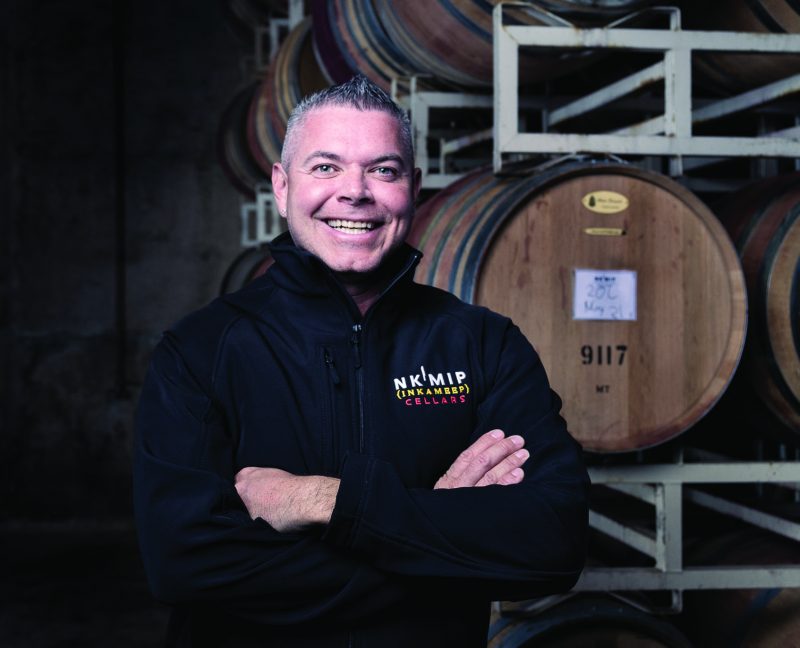
This article originally appeared in the Fall 2021 print issue of Quench Magazine.
Justin Hall is pretty excited these days, and with good reason.
In July, he was appointed head winemaker at Nk’Mip Cellars in the South Okanagan. As a member of the Osoyoos Indian Band that makes him the first Indigenous head winemaker on the continent— and, possibly, in the world.
Hall brims with optimism. He’s supremely passionate about his work and a true testament to how successful a vehicle Nk’Mip has become for the band.
Hall took over the role from his mentor, Randy Picton, who retired from the position in late June of 2021. Nk’Mip’s founding wine-maker in 2002, Picton originally hired Hall as a cellar-hand in 2004. Within just a few days, the young worker was firmly convinced that someday he would become a winemaker. With Picton’s encouragement, he went on to study winemaking and viticulture at
Okanagan University College, later traveling to Western Australia to work at Goundrey Winery. Ultimately he received his Graduate Diploma in Viticulture and Oenology from New Zealand’s Lincoln University.
No stranger to viticulture, many of Hall’s family had, over the years, worked at the Inkameep Vineyards in Osoyoos, which was among BC’s most significant early plantings and very much a foundation of the modern British Columbia industry.
Actually, Nk’Mip Cellars (which opened in 2002) was an ongoing part of a long story where First Nations very much helped drive both the early and present industry.
This fact is often overlooked. Almost lost in the very palpable excitement that surrounds the ascent of
BC’s industry is the fact that Indigenous People in BC have played a pivotal role in laying the groundwork for today’s success— in particular, the Osoyoos Indian Band (OIB).
Prior to the mid-1960s, wine grape plantings in the Okanagan were few and far between, amounting to around 250 acres. However, in 1968, Andrew Peller teamed up with the OIB to establish the fledgling Inkameep Vineyard, just north of Oliver. The BC government had permitted Peller to establish his Port Moody winery on the condition that he would also plant a vineyard in the Okanagan. In the interim, Victoria allowed him to import fruit from California. When Peller’s initial plantings in the Similkameen were less than successful, he turned to the Osoyoos Band as a partner.
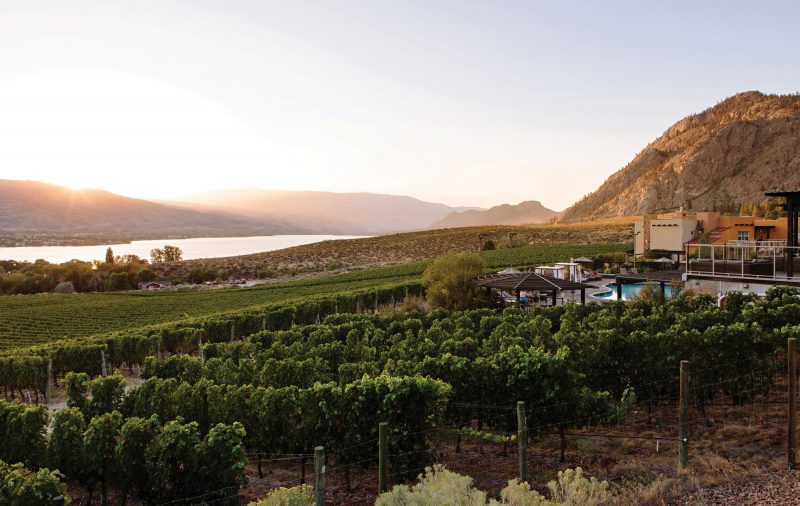
At the time, many First Nations people had to travel well away in search of work, such as picking fruit in Washington State. These were early days in the BC wine industry, where the emphasis was still on hybrids and, above all, volume. However, the subsequent success of Inkameep (as well as a shift to quality vinifera) resulted in more families being able to find employment closer to home and stay together.
In 1980, the band constructed an industrial building north of Oliver and leased it to T.G. Bright and Co. which equipped it as a winery with state of the art equipment. It evolved to be Jackson-Triggs Estate Winery and is now the Arterra Winery. First Vincor and then later Arterra made considerable investments and improvements, investing some $45 million as time went on. However, most importantly, the majority of the employees were, and are still, band members.
During the late 1960s and ‘70s, large tracts of vacant land and areas off the reserve were being developed into agriculture, recalls Osoyoos Indian Band Chief Clarence Louie. He says that conditions were indeed favourable to start a vineyard, especially given some of the economic development funds available.
“Over the years, that vineyard eventually grew to be one of the biggest privately owned vineyards in the country,
now 230 acres,” notes Louie. He also feels that somewhere between 30 and 40 percent of all BC VQA wines are made from grapes grown on band-held lands. He points out that all of BC’s major wineries, including Mission Hill, Andrew Peller and Arterra, lease vineyards on Osoyoos Indian Band land amounting to around 1500 acres.
The Chief recalls that initial discussions about the Band building its own winery were taking place as early as the mid-1970s. “No question, it’s the dream of every major vineyard owner to eventually have their own winery,” he says.
“Everybody talks about doing these things, but unless you have the money and expertise, it ends up being just talk. Everybody has a dream and most of the time their dreams never happen,” he adds. “It never did come about until Vincor wanted to lease over 1,000 acres of our land for what (then- Vincor CEO) Don Triggs called The Big Idea.”
As to where The Big Idea came from, Triggs says: “We were scratching our heads one day, wondering how the First Nations were able to be so successful in developing casinos. We thought: why couldn’t we take that same idea and evolve it into the wine industry—where we didn’t have to own the land? The First Nations would continue to own the land. We could develop a partnership, where we worked together in the mutual interests of both the Band and Vincor.
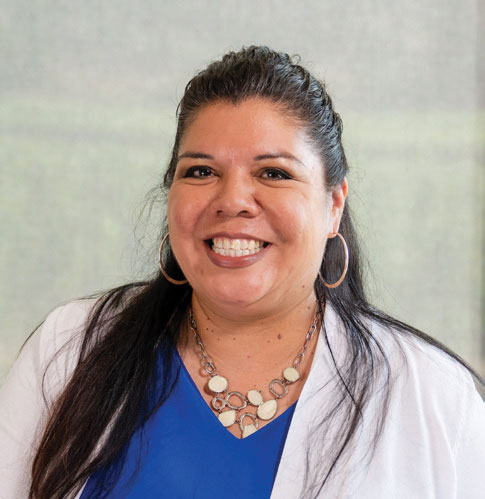
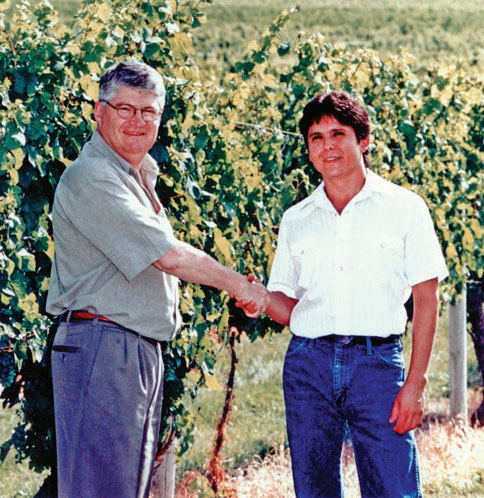
We called it The Big Idea. But it really wasn’t. We actually got the idea from what the Band had been doing with their casinos. So we just transplanted the idea to the wine industry.”
Chief Louie says he told Triggs that if he was to recommend that his people lease out such a significant amount of band property it would have to be approved through a band referendum. “Also, if we were going to do that we would want something major back. And that was going to be a joint venture winery,” he says.
Up to that point, the Band hadn’t been able to move ahead because they lacked the expertise but, says Louie, “We convinced Vincor. They wanted something from us and we wanted something from them: that’s a pretty good partnership.”
Triggs says it’s important to give some of the credit to Ed Arnold (then president of Bright’s). “It’s been a very long relationship. In 1981, it was Ed who really initiated the relationship with the Osoyoos Indian Band and Sam Baptiste, the OIB chief at the time,” he notes.
“The vision of the OIB has been really well nurtured by Clarence Louie. This is the fifth generation of management that has evolved since the first investments were made on the land and in the wine industry. The only constant has been the Band and, for a large part, it’s been Clarence. I had a great time working with him. He was always consistent, always setting high goals. And he was reliable. When he said something he delivered.”
He concludes: “I just have an enormous amount of respect for him, his integrity and his leadership skills. I wish him and the Band well. And I’m really pleased to have been a part of helping them along the way.”
Louie, who has initiated numerous projects (including the Nk’Mip Resort that’s home to the winery), feels that First Nations people see
numbers, we don’t have just one bottom line, like most entrepreneurs. Most white people only look at the profit side. We also have another bottom line, probably even more important than that—the jobs and career opportunities that come out of that operation.”
Robert Louie says that he, too, dreamed about a winery for many years. The former (over 24 years) Westbank First Nation Chief and his wife, Bernice Louie, opened West Kelowna’s Indigenous World Winery in 2016.
“As a young fellow growing up, I always worked for others in the industry, including in vineyards and orchards. I always aspired to eventually being an owner,” he says.
The more Robert Louie was involved in politics and business, the more convinced he became. His opportunity arose when he met “wonderful winemaker, Jason Parkes,” who’s also the brains behind wineries such as The Hatch, and Crown & Thieves, and other pace-setting projects.
“We decided this was an opportunity to not only establish a new winery but also to promote Indigenous culture—in a very positive way,” says Louie, as he describes the beginnings of the winery and (more recently opened) Indigenous World Distillery. Guests are introduced not just to the wines but to Syilx, artworks throughout the winery, along with bites of traditional cuisine at the distillery tasting bar.
Louie, whose children also work in the winery, says most visitors are locals but others come from all over, including Asia and Europe. “Some are pleasantly surprised to see an Indigenous-owned wine business so openly focused on the culture. The response is generally always favourable. People are impressed. They love the culture. They love hearing the stories about the wine, about the labels, and about our family history represented on the bottles,” he says.
Both Indigenous World and Nk’Mip Cellars, with its impressive Nk’Mip Desert Cultural Centre, are important milestones in the jour-ney of the Syilx, Okanagan Nation. But while success stories such as Justin Hall and others may be gratifying it can still be challenging for First Nations people to advance in the wine industry.
An adopted, full-status Kehewin Cree Nation member, Eliana Bray is one of just a few Indigenous certified sommeliers. Bray got her introduction to the wine industry in 2000, working at Mission Hill prior to the building of the new winery. She later moved to Vancouver for studies and started working as an assistant manager at the original Mark Anthony Wine Shop which led, in turn, to several key positions managing the company’s Artisan Wine Shops.
Bray worked hard to hone her wine knowledge and qualifications, became a certified sommelier through the ISG (International Sommelier Guild) and WSET certified (Level 3) and is currently enrolled in the WSET Diploma program. Eventually she moved on to open a number of locations for Firefly Fine Wines & Spirits before returning to the Okanagan to establish ZWine Ninja Consulting. Those plans have been on hold since 2018, when she became executive manager at Roche Wines in Naramata.
“Then COVID happened,” she says. “And my main focus was making sure that Roche was still around. And we are!” She adds that the decision to build a new website last year (in part to support the wine club) has paid off in spades.
“We did even better during COVID than a normal year, and this year we’re even further ahead.”
Bray says she’s faced no shortages of career challenges along the way.
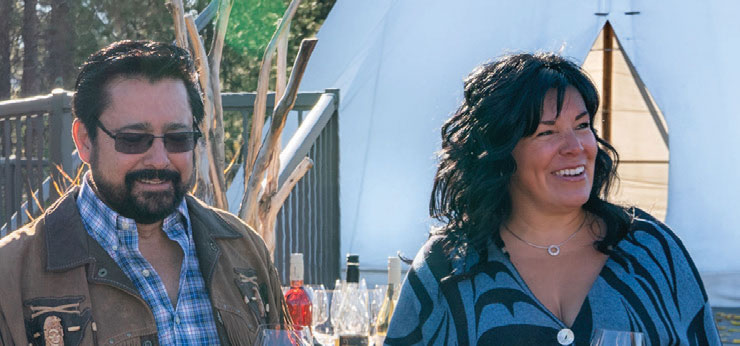
“People are impressed. They love the culture. They love hearing the stories about the wine, the labels and about our family history represented on the bottles”
“It just seems to me that most management positions in liquor were male dominated and they were mainly white males. It almost seemed that to be considered for a position I needed to be even more qualified to command a good salary. I guess that’s why I worked extremely hard,” says Bray, also a trained chef.
Part of the reason there aren’t many Indigenous women in wine, Bray feels, is due to the high cost of education. She is grateful to Vinica Education Society for awarding her a scholarship to attend their Wine Master Tasting
program. A not-for-profit, Vinica is dedicated to diversifying the wine industry through education and mentorship and is proactive in supporting people who are encountering systemic barriers in advancing their wine careers.
“Subconsciously,” says Bray, “I think I always felt I needed to achieve more. So one way to stand out was with my Twitter handle (@zwineninja), which has become my identity. Almost like being a force for good, it’s instilled in me the need to work harder than most people. It’s part of my personal drive. But… as a First Nations person, and as a female, I feel that I need to prove myself a bit more.”
Tim Pawsey (aka the Hired Belly) is a well-seasoned food and wine journalist who’s spent the last few decades documenting in particular the ascent of British Columbia wine and food. He has also traveled to most of the world’s major wine regions. Tim is a founding director of the BC Hospitality Association (which supports those in the hospitality industry facing financial crisis due to a health condition). His favourite travel destination is Lisbon, Portugal and his go-to restaurant that never disappoints is Le Crocodile in Vancouver, BC.

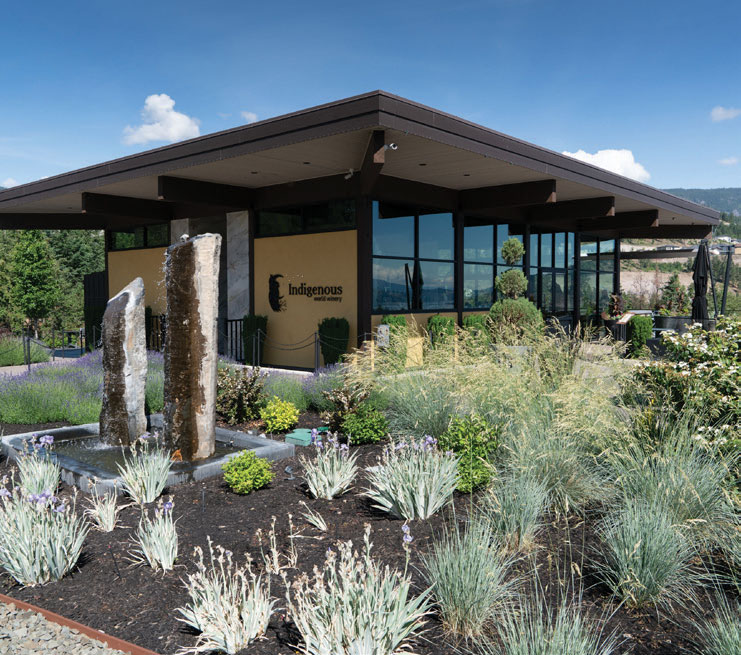

Great read. Big fan of Justin Hall.